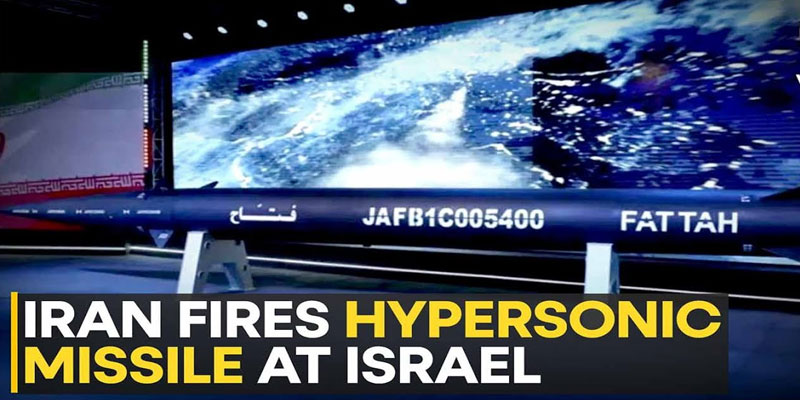The Rise of Hypersonic Warfare
In a stunning turn of escalation, Iran has launched its first confirmed hypersonic missile strike on Israel using the Fattah-1 system, a move that signals a dangerous leap in the regional arms race. Hypersonic weapons, capable of maneuvering at speeds exceeding Mach 5, are nearly impossible to intercept with existing missile defense systems.
This marks a significant moment in modern warfare, with Iran becoming the latest nation to operationalize hypersonic technology in live conflict. The deployment of Fattah-1 raises concerns about the destabilizing effects such technology could have in an already volatile Middle East.
All About the Fattah-1 Missile
First unveiled in 2023, the Fattah-1 hypersonic missile is Iran's flagship advanced strategic weapon. Developed by the Islamic Revolutionary Guard Corps (IRGC), the missile is 12 meters in length, uses solid fuel, and has a reported range of up to 1,400 kilometers.
What sets Fattah-1 apart is its hypersonic glide vehicle (HGV) warhead. This enables the missile to maneuver unpredictably in the atmosphere, making it extremely difficult for conventional interception systems like Israel's Iron Dome or Arrow defense systems to neutralize. The missile can travel at speeds of up to 17,900 kilometers per hour and carry a payload of approximately 200 kilograms of explosives.
Described by Iranian state media as the "Israel-striker," Fattah-1 has been engineered specifically to overcome Israel’s layered missile defense infrastructure.
The Missile Strike and Tehran's War Rhetoric
On Wednesday, the IRGC confirmed the launch of Fattah-1 missiles as part of the 11th wave of "Operation Honest Promise 3." Iran’s Supreme Leader, Ayatollah Ali Khamenei, declared a battle cry on social media, stating, "We will show the Zionists no mercy."
Alongside the hypersonic missiles, Iran deployed a swarm of drones targeting Israeli airspace. The IDF confirmed interceptions over the Dead Sea, but acknowledged difficulty in countering the sheer scale and speed of the Iranian assault.
This is the second reported use of Fattah-1, with its first deployment occurring during Operation True Promise II in October 2024. However, its use now comes with intensified geopolitical consequences, as Tehran seeks to frame its actions as a response to Israeli airstrikes that killed senior Iranian commanders, including Ali Shadmani and Gholam Ali Rashid.
Israel's Response and Strategic Escalation
Israel's counter strikes have not been limited to tactical sites. Early Wednesday, Israeli warplanes reportedly hit several neighborhoods in Tehran, including Piroozi and Sayyad, causing civilian casualties and urban devastation.
Israeli forces also launched a major airlift operation to evacuate over 50,000 stranded citizens globally, signaling expectations of prolonged conflict.
Adding to the gravity of the situation, Israeli defense stocks surged amid market turbulence, and reports indicate a shortage of Arrow missile interceptors, raising concern about Israel's long-term defense capability against high-speed threats.
Regional and Global Fallout
The conflict has triggered a cascade of international responses. China evacuated nearly 800 citizens from Iran, citing worsening security. Oil prices soared, and global financial markets took a hit as investors reacted to the potential for wider war.
In the United States, President Donald Trump has taken a belligerent tone, demanded Iran's "unconditional surrender" while also claimed no involvement in Israel's bombing campaign. Trump’s cryptic remarks about knowing Khamenei's location, coupled with threats of assassination, signal dangerous escalation. He convened the National Security Council to weigh potential U.S. military intervention, further fueling fears of a broader war.
The U.S. embassy in Jerusalem was temporarily closed, and speculation is mounting that Washington could be drawn into direct conflict.
A Perilous New Frontier
The use of hypersonic weapons in the Iran-Israel conflict marks a disturbing milestone in modern warfare. The deployment of Fattah-1 is not just a show of strength by Tehran but a stark warning of how advanced technology could upend strategic balances.
For Israel, the challenge lies in adapting its defense infrastructure to this new threat. For the world, the concern is even larger: a localized conflict now has the potential to spark a global confrontation involving major powers.
The situation underscores the urgent need for international diplomacy to contain hypersonic proliferation and avoid miscalculated escalations. In this high-stakes chess game, one wrong move could alter the course of history.
(With agency inputs)






















